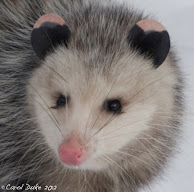When seeing these brightly painted butterflies in the gardens, it can be hard to distinguish one from the other. Both American Lady and Painted Lady adults will go for a diverse range of nectar sources. Their appearances are more akin than their lifestyles which vary in caterpillar food choices, distribution and overwintering tendencies.
Painted Lady on Eupatorium purpureum commonly known as Joe-Pye weed.
The Painted Lady is more worldly than the American Lady and can be found in most sun-drenched open habitats throughout the world. This slightly larger and more vibrant butterfly in its larva stage shares a taste for composites with the American Lady but also enjoys a variety of mallows and other plants. Pearly Everlasting is a favorite of both caterpillars.
Wings fully opened, a Painted Lady reveals more clues to her identity, while the mysterious little beetle companion mirrors orange and white hues.
The Painted Lady is a migrant butterfly not being able to overwinter here in New England, where the American Lady is hardier and hibernates as an adult butterfly or in a chrysalis stage.
A discerning eye can pick out the signs that shout American Lady above, while Painted Lady below.
Painted Lady above and American Lady below.
Note the solid black dots along the bottom of both upper side hindwings in the Painted Lady, where as the American Lady dons marks more similar to eyespots on its upper hindwings. I find the tiny white dots on the orange of the forewings of the American Lady a helpful hint too. There are many other differences but once these clues are fixed in our memories they stand out clearly in defining the butterflies.
An American Lady nectaring on an Erigeron speciosus conveniently reveals the above mentioned marks, as well as, the important two large eyespots on her underside hindwing. The Painted Lady below wears four smaller eyespots on her underside hindwing. When the wings are folded this is a definitive telling in identifying these two ladies. The American Lady is also a bit smaller than the Painted Lady.
The American Lady has two larger eyespots while the Painted Lady sports four smaller eyespots on the underside of the hindwings. I will be looking for caterpillars of the American Lady on Edelweiss when I visit nurseries this spring and look forward to welcoming these two beauties back to Flower Hill Farm gardens and fields in the upcoming months.
Meanwhile back in real time . . . first day of spring time . . . March roars with winter's last grip.
Bob does not look too happy wearing his snow bib and wild white hair with snow cotton in his ears.
He does not wish to hear anymore of winter now that the Spring Equinox is here.
Snow fell incessantly throughout the last day of winter.
It is inspiring to have beautifully painted butterflies, sighted in last years gardens and fields, fluttering around in layers of memory within the mind, especially on a day when our calendars announce spring and all we New Englanders can see are landscapes that speak starkly-white winter wonderlands. Snow had nearly melted into a waking earth before the last eight inches of fresh stuff fell and even tiny snowdrops had pushed their green stems up, but, alas, they will have to go back to sleep for awhile yet.
Happy Spring Equinox!












































































































































